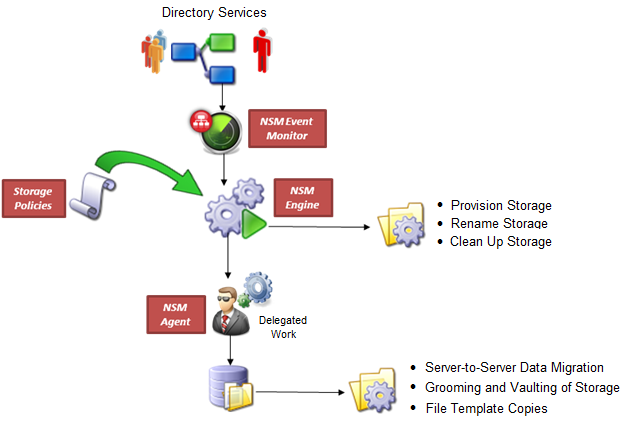2.0 Overview
Novell Storage Manager introduces management and structure to an unmanaged and unstructured network storage system. In the process, it automates the full life cycle management of user and group storage. Leveraging directory services (commonly referred to as “the directory”), Novell Storage Manager automates a comprehensive set of storage management tasks based on events, identity, and policies.
The Directory
Microsoft Active Directory stores the identity information about the users and groups that Novell Storage Manager manages. When Novell Storage Manager is installed, it adds or modifies user and group attributes so that they can be managed through Novell Storage Manager.
Events
When a user in Active Directory is added, moved, renamed, disabled, or deleted, it is known as a directory “event.”
Policies
Policies within Novell Storage Manager indicate what storage-specific actions to enact when an event in Active Directory takes place. These actions include creating user or collaborative storage when a new user is added to Active Directory, moving storage when a user is moved from one organizational unit or group to another, and archiving or deleting storage when a user is removed.
Novell Storage Manager lets you create the following types of policies:
User Home Folder: Manages home folders for users who access their storage from an assigned user workstation.
User Profile Path: Used for profile path management
User Remote Desktop Services Home Folder: Used for users who get network access from remote client machines. Prior to Windows Server 2008, these were referred to as Terminal Services Home Folders.
User Remote Desktop Services Profile Path: Used for profile path management for users who get network access from remote client machines.Prior to Windows Server 2008, these were referred to as Terminal Services Profile Paths.
Container: Manages the users located in an organizational unit.
Group: Manages the users that are members of a group.
Auxiliary: Manages one or more additional storage locations in association with one of the four user policy types.
NSM Engine
The NSM Engine performs actions based on events in Active Directory and the defined Novell Storage Manager policies. These actions include provisioning, moving, grooming, deleting, renaming, and vaulting in the file system. There is only a single NSM Engine per forest and it can be installed on a domain controller or a member server. The NSM Engine runs as a native NT service on Windows.
Event Monitor
The Event Monitor monitors changes to Active Directory based on create, move, rename, and delete events. You install one Event Monitor per domain, and it can run on a domain controller or a member server. If you install the Event Monitor on a domain controller, the Event Monitor always monitors the local server for changes in the domain. If the Event Monitor is installed on a member server, it identifies the closest available domain controller and monitors it for changes in the domain. The Event Monitor runs as a native NT service on Windows.
NSM Agent
NSM Agents perform copying, moving, grooming, deleting, and vaulting through directives from the NSM Engine. For optimum performance, NSM Agents should be installed on all servers with storage managed by Novell Storage Manager. The NSM Agent runs as a NT native service on Windows.
